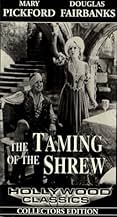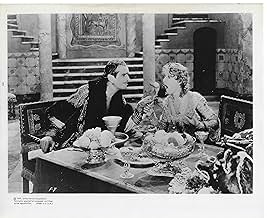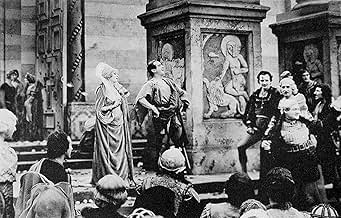In sixteenth century Padua, Hortensio loves Bianca, the youngest daughter of Baptista. But Baptista will not allow the two to get married until his eldest daughter, the extremely headstrong ... Read allIn sixteenth century Padua, Hortensio loves Bianca, the youngest daughter of Baptista. But Baptista will not allow the two to get married until his eldest daughter, the extremely headstrong Katherine, is betrothed. This task seems impossible because of Katherine's shrewish demean... Read allIn sixteenth century Padua, Hortensio loves Bianca, the youngest daughter of Baptista. But Baptista will not allow the two to get married until his eldest daughter, the extremely headstrong Katherine, is betrothed. This task seems impossible because of Katherine's shrewish demeanor. They believe their prayers have been answered with the arrival from Verona of the lust... Read all
- Director
- Writers
- Stars
- Awards
- 2 wins total
- Director
- Writers
- All cast & crew
- Production, box office & more at IMDbPro
Featured reviews
The big problem is that Pickford is so small; when I got my first look at her, she looked like a little girl playing at fancy dress. Taylor stages things so she is equal in height or taller than Fairbanks when they are side by side, but when standing apart she is obviously much shorter. Maybe a match in bad manners, but she is obviously not his physical equal. For example, she is blown about by a high wind in one scene, while Fairbanks is unaffected.
Fairbanks as Petruchio is actually playing one of his swashbucklers, and Pickford as Kate is one of her many spunky waif characters. She does not inspire fear, just a "isn't that precious!" reaction given her size. Notice that when Pickford is supposedly beating up servants and smashing furniture, she does so out of view of the camera, because someone her size would not be capable of doing all of that damage.
The odd thing is that the film looks like great care went into the art direction and photography, and the supporting players are pretty good. Neither Fairbanks nor Pickford have that stiff early talkie way about them, but they are given to wild gestures as though they are still in a silent film. So it is the little things that are done well and with care, while it is the big things that sink the film. I'd give it 5/10 with four of those five going to the physical production design.
Hollywood royalty Douglas Fairbanks and Mary Pickford star as Kate and Petruchio, the warring couple who really love each other on the sly. Their marriage was a sham by the time this flick came out, and both their careers were on the wane, but they give reasonable enough performances, even though Fairbanks looks a few years too old for his part when the camera gets close. There's still a tendency to exaggerate their gestures and overact to responses to words being spoken, but they're no worse than any other stars making their first sound films.
It's clear that Hollywood back then had no more confidence in the intelligence of its audience than it does today: this is Shakespeare for the common man, with the pith of the Bard's prose removed in order to make the words readily understandable to all. Although the film is little more than an hour long, it does begin to drag during the last twenty minutes but, that aside, it's not a bad effort.
Of the two stars, Doug is clearly the better. Director Sam Taylor moulds the roles around the performer, and not the other way around, which was unwise but understandable. The Fairbanks image suits Petruchio better than Pickford's suits Kate. (At her best Pickford is magnificent, at her worst embarrassing. She herself called it one of her worst performances, and there is no reason to doubt her.)
For an early talkie it has remarkable fluidity, though it is only the 1966 re-edited version that is available today. (When I approached the Mary Pickford Company in 1992 to see if I could arrange a screening of the 1929 release print - which was longer and had a different score - I was politely but firmly told to go away!)
Two points of interest. This film was emphatically not the box office flop that many writers have claimed; it returned a healthy profit on its first release. And the credit line "by William Shakespeare, with additional dialogue by Sam Taylor" is pure myth. It appears not in the script, the 1966 nor in the 1929 (I have it on reliable authority) prints of the film. Where do these things get started?
Did you know
- TriviaIn her later years, Mary Pickford stated that working on the film was the worst experience of her life, although she also acknowledged that Douglas Fairbanks's performance was one of his best.
- Alternate versionsAfter many years out of circulation, the film was re-released in 1966 in a new cut supervised by Mary Pickford herself. New sound effects were added throughout, much of the voice dubbing was enhanced with newly available technology, and seven minutes were cut from the initial print. This re-released version is the only version now available on DVD or VHS.
- ConnectionsFeatured in Mary Pickford: A Life on Film (1997)
Details
- Release date
- Country of origin
- Language
- Also known as
- The Taming of the Shrew
- Filming locations
- Production companies
- See more company credits at IMDbPro
Box office
- Budget
- $504,000 (estimated)
- Runtime
- 1h 3m(63 min)
- Color





























